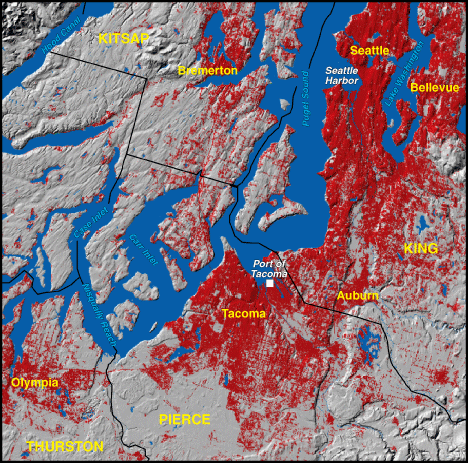Seattle-Tacoma, Washington 1973


|
1970 Population - 1,750,339
Includes King, Pierce, Thurston, and Kitsap Counties. NOTE: portions of the above listed counties may not be visible on the map |
Seattle was settled in 1851 and grew from a tiny sawmill town into a metropolitan area with a diverse population exceeding 2.6 million. The sister cities of Seattle and Tacoma sprawl between Puget Sound and the Cascades. They are the sites of major ports (the shortest shipping route to the Pacific Rim), a large airplane manufacturing hub (Boeing), and a high-tech industry center (led by Microsoft). Initial growth in the Puget Sound area came from timber harvesting, the Alaskan gold rush, and the northern transcontinental railroad. Seattle's population reached 237,000 by 1910. World War II spurred growth when people arrived to work in aircraft and shipbuilding industries powered by regional hydroelectricity. |
Seattle-Tacoma, Washington 1992

|
1990 Population - 2,444,477
Includes King, Pierce, Thurston, and Kitsap Counties. NOTE: portions of the above listed counties may not be visible on the map Red areas shown as developed land 339,400 acres (530 square miles) |
Seattle grew at least 30 percent per decade between 1940 and 1970. King County ranked 18th nationally among counties in terms of absolute population gain between 1970 and 1990 and Pierce County ranked 54th. New additions included more inland suburbs and exurbanization on the islands of the Sound. As the cities continued to expand, a low-density "urbanscape" formed from Olympia in the south to Vancouver, Canada, in the north. The rapid growth created challenges, such as traffic congestion, loss of wildlife habitat, natural hazard mitigation, and housing inflation. Area residents currently face complex decisions as they attempt to balance future growth with a unique quality-of-life. |